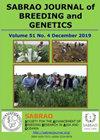EFFECTIVENESS OF 7S GLOBULIN AGAINST BOTRYTIS CINEREA CAUSING GRAY MOLD IN STRAWBERRY
IF 1.7
Q3 PLANT SCIENCES
引用次数: 0
Abstract
Gray mold caused by Botrytis cinerea is the most harmful postharvest disease responsible for the degradation of strawberries. The presented study targeted the preparation of 7S globulin from pea seeds to serve as an antifungal agent against B. cinerea in vitro and on the post-harvest strawberry to extend the fruits’ shelf life. The 7S globulin isolation from pea seeds and characterization employed various methods, such as SDS-PAGE, FTIR, and pH solubility curve. The molecular technique also helped confirm the identity of the causative microorganism of the gray mold disease in strawberries. Utilizing rRNA gene sequencing identified a fungal pathogen that causes gray mold as B. cinerea. The 7S globulin showed three protein bands corresponding to α/ (83 KDa), α (68 KDa), and β (60 KDa) subunits. The isoelectric point was notable at pH 5.8. The essential and non-essential amino acids occurred around 24.92% and 54.04%, respectively. The 7S globulin inhibited the mycelial growth of B. cinerea in a concentration-dependent manner. The Scanning Electron Microscope (SEM) of B. cinerea subjected to 7S globulin showed swelling of both the fungal hyphae and conidia, significantly affected by the pea 7S-globulin treatment, entirely destabilizing and deforming their shape at 0.4 g/L. The 7S-globulin exposure maintained the fruit quality and stopped the strawberry’s natural deterioration. Results further authenticated that 7S globulin (isolated from pea seeds) revealed effective antifungal action against B. cinerea mycelial development via a membrane-targeted mechanism. The 7S globulin affects hyphal morphology, compromises plasma membrane integrity, and prevents post-harvest gray mold on strawberry fruits.7s球蛋白防治草莓灰霉病的效果研究
灰霉病是草莓采后危害最大的病害之一。本研究以豌豆种子为原料制备7S球蛋白,在体外和采后草莓中作为葡萄球菌的抗真菌剂,以延长果实的保质期。采用SDS-PAGE、FTIR、pH溶解度曲线等多种方法对豌豆种子中的7S球蛋白进行分离和鉴定。分子技术还有助于确认草莓灰霉病的致病微生物的身份。利用rRNA基因测序鉴定出一种引起灰霉病的真菌病原体为灰霉菌。7S球蛋白显示了α/ (83 KDa)、α (68 KDa)和β (60 KDa)三个亚基的蛋白带。pH值为5.8时等电点显著。必需氨基酸和非必需氨基酸的含量分别为24.92%和54.04%。7S球蛋白对灰葡萄球菌菌丝生长具有浓度依赖性。7S球蛋白作用下的灰绿杆菌菌丝和分生孢子的扫描电镜(SEM)显示,在0.4 g/L的浓度下,7S球蛋白对真菌菌丝和分生孢子的影响显著,菌丝和分生孢子完全不稳定,形状变形。7s球蛋白保持了草莓的果实质量,阻止了草莓的自然变质。结果进一步证实,从豌豆种子中分离的7S球蛋白通过膜靶向机制对灰葡萄球菌菌丝发育具有有效的抗真菌作用。7S球蛋白影响菌丝形态,损害质膜完整性,防止草莓果实收获后灰霉病的发生。
本文章由计算机程序翻译,如有差异,请以英文原文为准。
求助全文
约1分钟内获得全文
求助全文
来源期刊

Sabrao Journal of Breeding and Genetics
农林科学-奶制品与动物科学
CiteScore
1.90
自引率
50.00%
发文量
63
期刊介绍:
The SABRAO Journal of Breeding and Genetics is an international journal of plant breeding and genetics research and was first published in 1969. It is the official publication of the Society for the Advancement of Breeding Research in Asia and Oceania (SABRAO).
Its objectives are to: promote the international exchange of research information on plant breeding and genetics, by describing new research findings, or ideas of a basic or practical nature; and be a medium for the exchange of ideas and news regarding members of the Society.
The Journal gives priority to articles that are of direct relevance to plant breeders and with emphasis on the Asian region. Invited for publication are research articles, short communications, methods, reviews, commentaries, and opinion articles. Scientific contributions are refereed and edited to international standards.
The journal publishes articles for SABRAO members mainly. The Journal preferred strongly that at least one author should be a current member of the Society. Non-members may also publish in the journal.
 求助内容:
求助内容: 应助结果提醒方式:
应助结果提醒方式:


